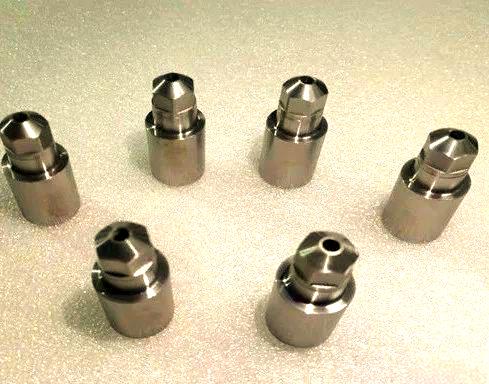
Chromium nitride (CrN) coatings perform well in low viscosity, high hardness, and wear-resistant applications, such as stamping molds, powder metallurgy molds, and injection molds. Compared to titanium nitride coatings, it has better corrosion resistance to aqueous solutions. In addition, the internal stress of chromium nitride coating is relatively low, allowing for the preparation of thicker coatings.
Detailed Explanation of Coating Parameters
- Coating color: Silver gray
- Coating elements: including Cr and N elements
- Coating hardness: up to 1800HV
Coating thickness: ranging from 2-6 μ m
- Friction coefficient: 0.35
Applicable temperature: up to 700 ℃
Feature Overview:
- Excellent corrosion resistance, significantly improving the durability of materials in corrosive environments;
- Excellent wear and tear resistance, significantly improving the frictional behavior of components;
- Suitable for surface protection of mirror and etched surface products, enhancing product aesthetics and durability;
- Low chemical affinity, easy to separate from conventional materials, thereby optimizing the demolding effect of the product;
- The preparation process of environmentally friendly materials ensures the release of non covalent Cr ions.
Application scope:
- Sliding friction parts: Chromium nitride coating can effectively reduce the wear of sliding friction parts and improve their durability.
- Automotive piston rings: This coating is suitable for automotive piston rings, significantly improving their tribological behavior and extending their service life.
- Injection mold cavity and sliding accessories: Chromium nitride coating can protect the injection mold cavity and sliding accessories, improving their corrosion resistance and wear resistance.
- High mirror mold: For high mirror molds, this coating can provide excellent surface protection, enhance product aesthetics and durability.
Chromium nitride (CrN) is an important compound and belongs to a type of metal nitride. It has excellent physical and chemical properties, such as high hardness, good wear resistance, corrosion resistance, etc. Therefore, it has broad application value in many fields. This article will provide a detailed introduction to chromium nitride: 1. Basic properties and characteristics. Chromium nitride is a silver gray solid powder or thin film substance with high melting point and chemical stability. It has good electrical and thermal conductivity, as well as high mechanical properties such as hardness and elastic modulus. In addition, it also exhibits excellent antioxidant and anti-corrosion capabilities. These unique physical and chemical properties enable chromium nitride to exhibit outstanding performance in many applications. 2、 Due to its excellent wear and corrosion resistance, as well as good thermal stability and mechanical properties, chromium nitride has become one of the ideal coating materials widely used in various industrial fields such as aerospace, automotive manufacturing, mold processing, petroleum drilling, etc. In these fields, it can significantly improve the life of materials and reduce maintenance costs, thereby bringing economic benefits. At the same time, with the continuous progress of science and technology and the expansion of application fields, people's research on chromium nitride is also constantly deepening, and new application prospects are constantly being explored. In the future, it will be widely used and have huge development space in more fields At present, the main methods for producing chromium nitride include gas reaction method, plasma spraying method, etc. Different processes and equipment have their own advantages and disadvantages in the production process, which need to be selected according to specific needs. In summary, chromium nitride, as a high-performance hard coating material and functional ceramic material, plays an important role in modern industrial production. It not only improves the quality and reliability of products, but also greatly promotes the development of related industries. In the future development, we will continue to explore its potential to achieve more innovative applications and improve people's quality of life





